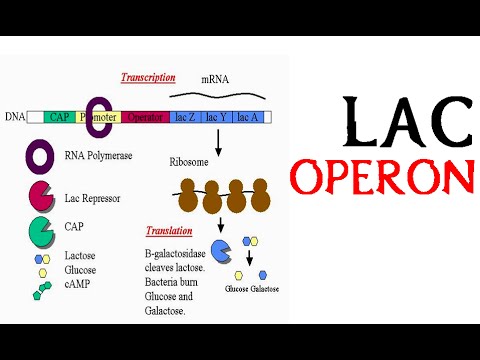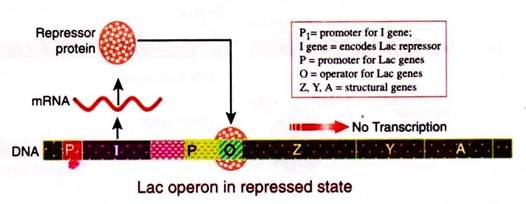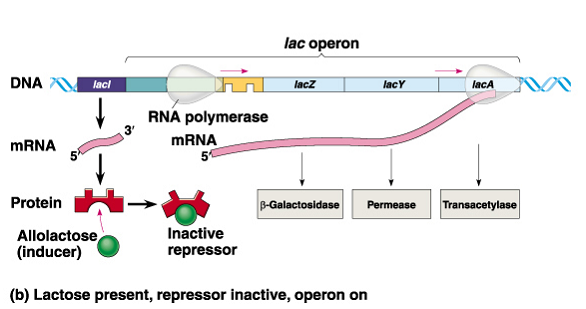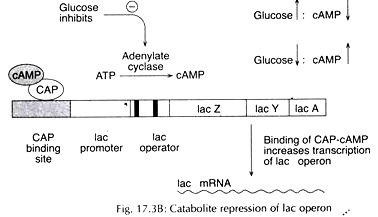
Epigenetic regulation of lac operon in E. coli
Lac operon
- A Classical example of epigenetic regulation of phenotypic heterogeneity is the utilization of lactose as a source of carbon and energy by E. coli.
- Lac operon are the cluster gene, promoter and some additional sequences that are regulated together which encodes enzymes responsible for lactose metabolism.
- Lac operon consists of two types of gene-structural gene and regulatory gene.
Structural gene includes- LacZ, Lac Y and Lac A
- LacZ: It encodes the enzyme β-galactosidase which converts lactose into allolactose (isomeric form) and also breaks a β-galactoside (lactose) into glucose and galactose
- lacY: It encodes the enzyme galactoside permease. It is transporter protein which facilitates the entry of lactose into cell
- lacA: It encodes the enzyme β-galactoside transacetylase. It modify toxic galactoside by transferring an acetyl group from acetyl-CoA to β-galactosides and remove out of cell.
Regulatory gene include Lac I along with Promoter and Operator sequence. Regulatory gene regulate transcription of structural gene.
- Lac I: It encodes Repressor protein. The repressor protein binds to operator near promotor.
- Promoter: It is the binding site for RNA polymerase.
- Operator: It is the binding site for repressor protein.
In early 1957, Novick and Weiner showed that culturing E. coli in the presence of lactose in the media (low level of lac operon induction) yields two sub populations of E. coli, one with high lac expression and the other non lac expressing. Until lactose is present, transcription of lac gene is repressed. Selective expression of lac gene is regulated by epigenetic phenomenon.
Lac operon is regulated by following mechanism
1. Repression: (In the absence of Lactose)
- Repressor gene encodes repressor protein that binds to operator
- Repressor protein is tetramer that is transcribed from LacI gene by its own promoter which is independent to lac operon.
- Repressor protein binds to region O1 of Operator. Lac operon two secondary binding site for repressor protein, region O2 which is near LacZ and region O3 which is upstream to promoter.
- The repressor seems to bind to region O1 and one of the secondary region. When repressor bind to operator, RNA polymerase cannot bind to promoter because binding of repressor to operator overlaps promoter preventing binding of RNA polymerase. Thus transcription of structural gene stops.
 figure: Repression of lac operon
figure: Repression of lac operon
Immediately addition of lactose in the media induces E. coli to synthesize enzymes responsible for lactose metabolism. But even in the repressed state Some E. coli have minimal level of B- galactosidase and galacotoside permease. This basal level is essential for operon regulation in the presence of lactose.
2. Induction: (In the presence of lactose)
- When lactose is present, it binds to specific site of repressor protein causing conformational change that dissociate it from operator.
- lactose is inducer here.
- Actually, lactose itself is not an inducer, but allolactose is. Allolactose is an isomer of lactose.
- β-galactosidase converts lactose into allolactose that binds to repressor protein and inactivate it, so that transcription of structural gene occur.
- Several other β-galactosides, structurally similar to allolactose can acts as inducer. Transcription of structural gene encodes the enzymes responsible for lactose metabolism producing glucose and galactose.
 figure: Induction of lac operon in presence of lactose as inducer
figure: Induction of lac operon in presence of lactose as inducer
3. Catabolic repression: (In the presence of glucose and lactose)
- It is regulated by CAP (catabolite activator protein) encoded by CAP gene located elsewhere in the chromosome.
- When CAP binds near promoter upstream to LacI, it facilitates binding of RNA polymerase to promoter more tightly so that the rate of transcription increases 20 folds.
- But initially, CAP is inactive. cAMP is required to activate CAP. cAMP is a secondary messenger which binds with CAP only in the absence of glucose.
- When the level of glucose is high in cell, synthesis of cAMP is inhibitated. Furthermore, glucose also transport cAMP out of cell, decreasing the concentration of cAMP in cell so that CAP is not activated. Thus transcription stops.

Feedback regulation of lac operon
- active transport of lactose by permease inside cell causes accumulation of higher inducer concentration resulting in increases expression of lac operon
- transgalactosylation of lactose by β – galactosidase produces allolactose, causing induction of lac operon
- β -galactosidase hydrolyses lactose and allolactose to produce glucose and galactose. Increases concentration of glucose causes catabolite repression.
